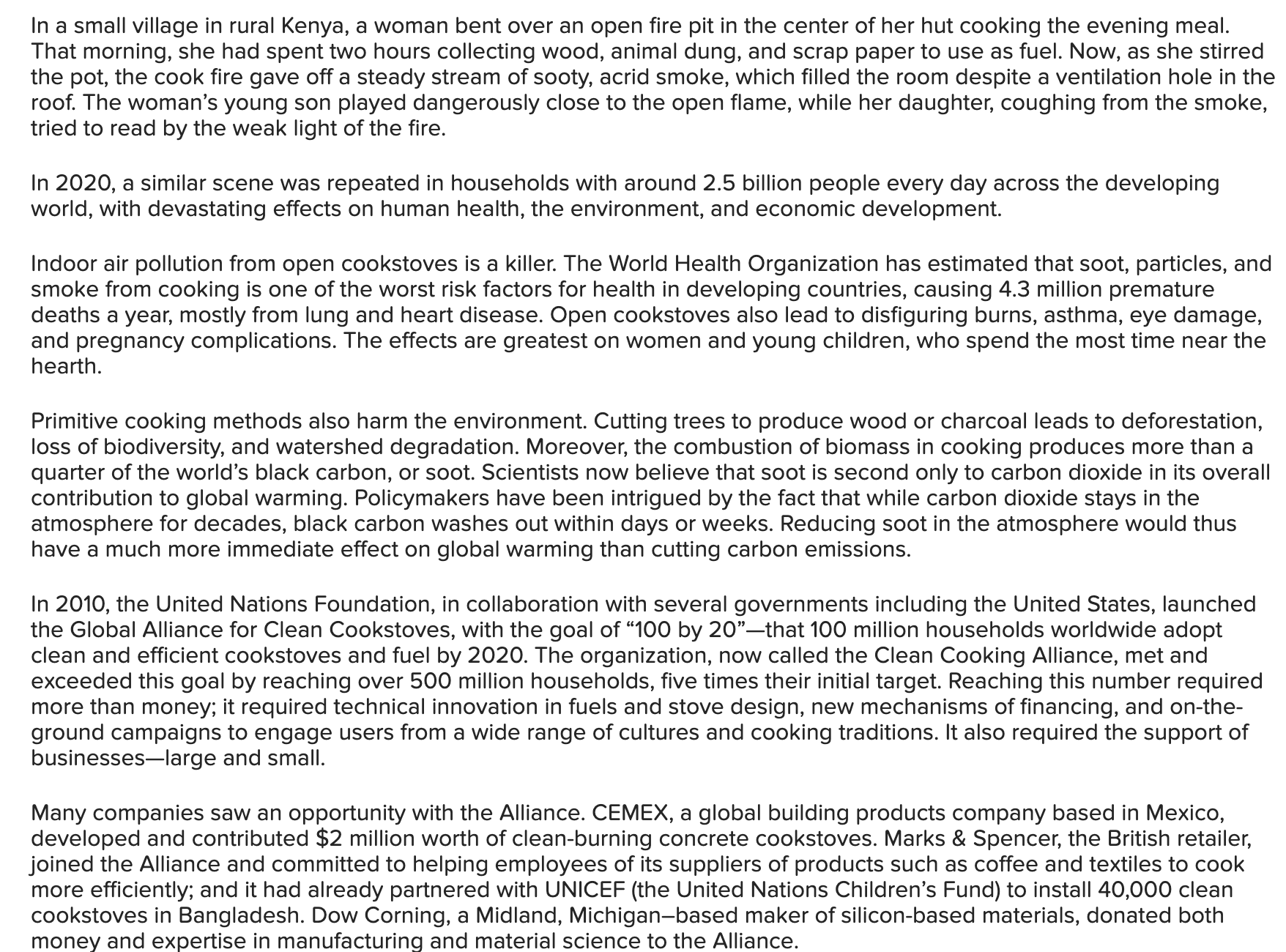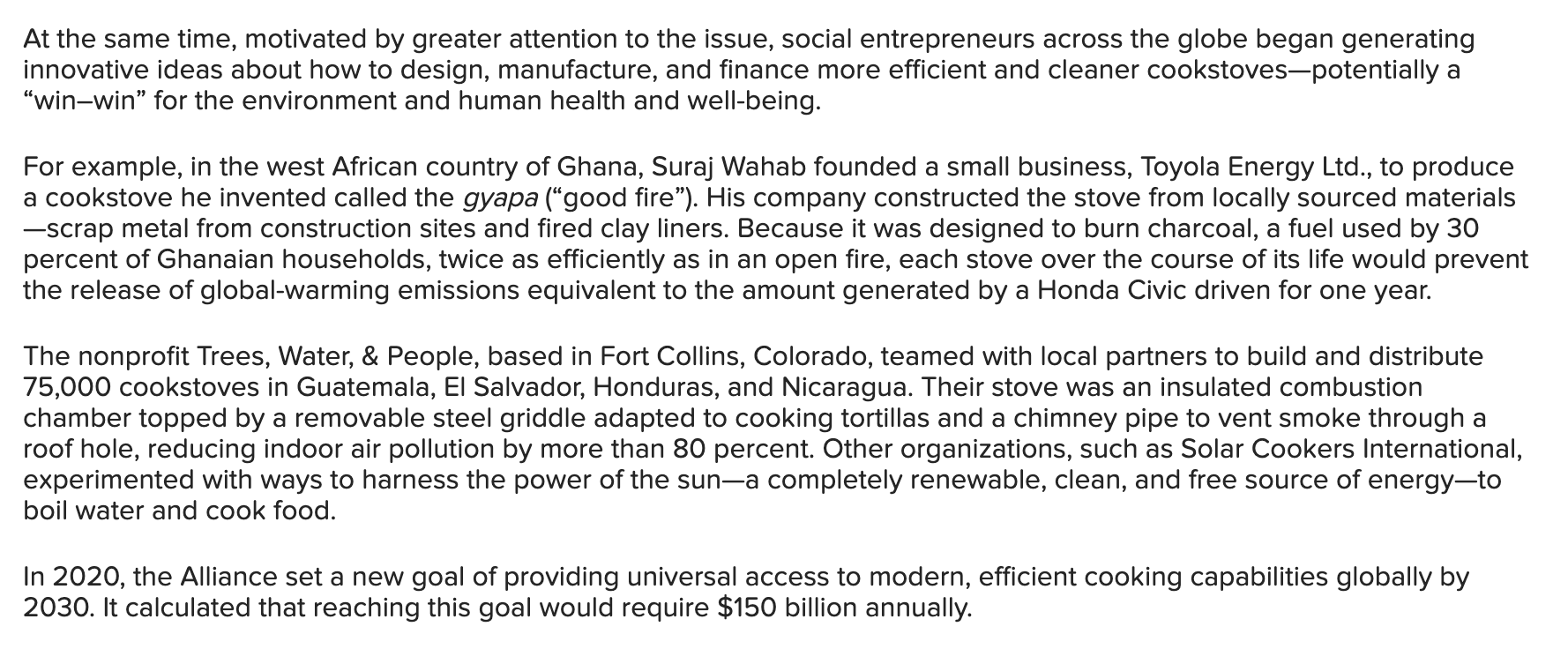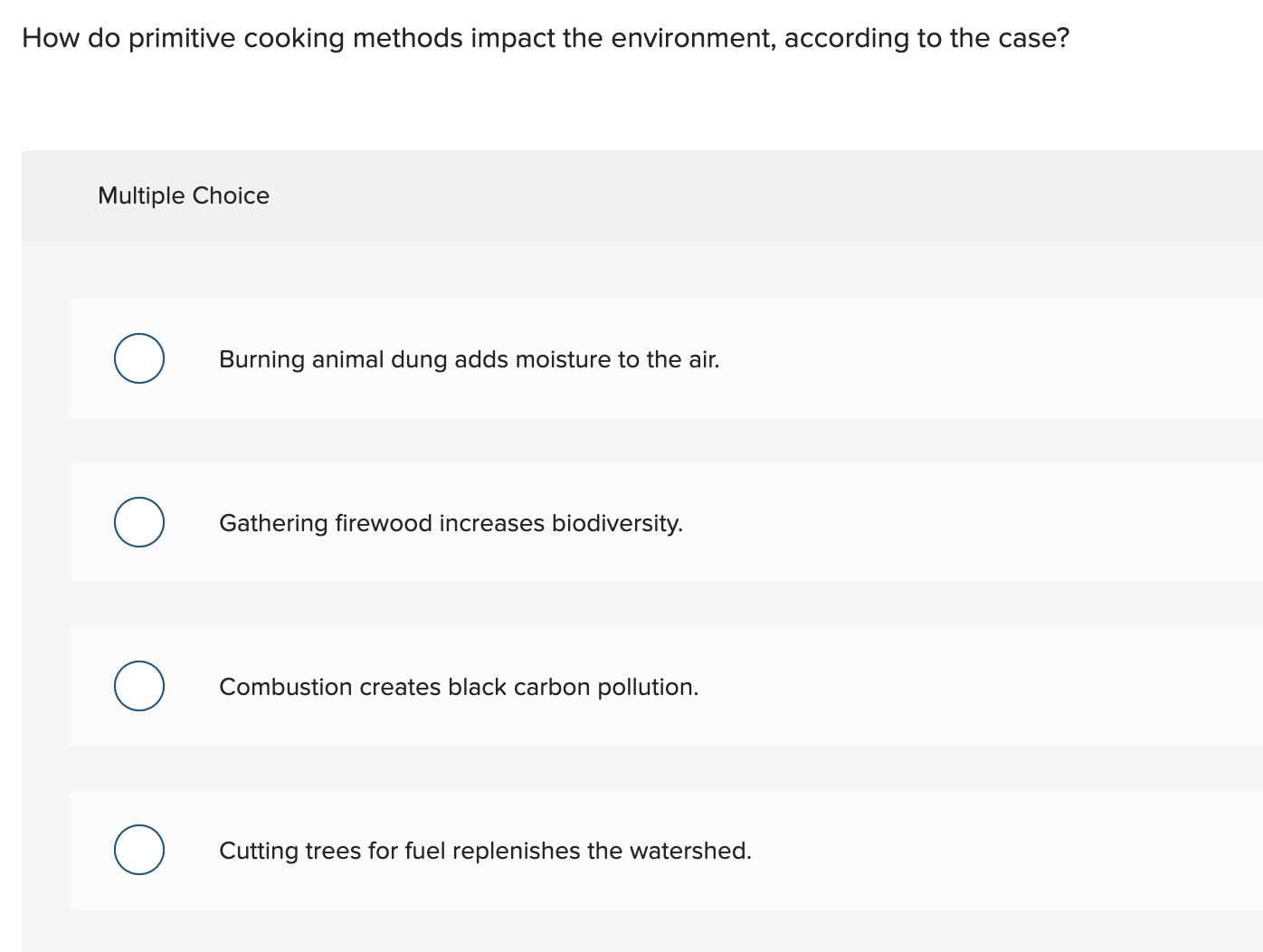Answered step by step
Verified Expert Solution
Question
1 Approved Answer
At the same time, motivated by greater attention to the issue, social entrepreneurs across the globe began generating innovative ideas about how to design, manufacture,


 At the same time, motivated by greater attention to the issue, social entrepreneurs across the globe began generating innovative ideas about how to design, manufacture, and finance more efficient and cleaner cookstoves-potentially a "win-win" for the environment and human health and well-being. For example, in the west African country of Ghana, Suraj Wahab founded a small business, Toyola Energy Ltd., to produce a cookstove he invented called the gyapa ("good fire"). His company constructed the stove from locally sourced materials - scrap metal from construction sites and fired clay liners. Because it was designed to burn charcoal, a fuel used by 30 percent of Ghanaian households, twice as efficiently as in an open fire, each stove over the course of its life would prevent the release of global-warming emissions equivalent to the amount generated by a Honda Civic driven for one year. The nonprofit Trees, Water, \& People, based in Fort Collins, Colorado, teamed with local partners to build and distribute 75,000 cookstoves in Guatemala, El Salvador, Honduras, and Nicaragua. Their stove was an insulated combustion chamber topped by a removable steel griddle adapted to cooking tortillas and a chimney pipe to vent smoke through a roof hole, reducing indoor air pollution by more than 80 percent. Other organizations, such as Solar Cookers International, experimented with ways to harness the power of the sun-a completely renewable, clean, and free source of energy-to boil water and cook food. In 2020, the Alliance set a new goal of providing universal access to modern, efficient cooking capabilities globally by 2030. It calculated that reaching this goal would require $150 billion annually. In a small village in rural Kenya, a woman bent over an open fire pit in the center of her hut cooking the evening meal. That morning, she had spent two hours collecting wood, animal dung, and scrap paper to use as fuel. Now, as she stirred the pot, the cook fire gave off a steady stream of sooty, acrid smoke, which filled the room despite a ventilation hole in the roof. The woman's young son played dangerously close to the open flame, while her daughter, coughing from the smoke, tried to read by the weak light of the fire. In 2020, a similar scene was repeated in households with around 2.5 billion people every day across the developing world, with devastating effects on human health, the environment, and economic development. Indoor air pollution from open cookstoves is a killer. The World Health Organization has estimated that soot, particles, and smoke from cooking is one of the worst risk factors for health in developing countries, causing 4.3 million premature deaths a year, mostly from lung and heart disease. Open cookstoves also lead to disfiguring burns, asthma, eye damage, and pregnancy complications. The effects are greatest on women and young children, who spend the most time near the hearth. Primitive cooking methods also harm the environment. Cutting trees to produce wood or charcoal leads to deforestation, loss of biodiversity, and watershed degradation. Moreover, the combustion of biomass in cooking produces more than a quarter of the world's black carbon, or soot. Scientists now believe that soot is second only to carbon dioxide in its overall contribution to global warming. Policymakers have been intrigued by the fact that while carbon dioxide stays in the atmosphere for decades, black carbon washes out within days or weeks. Reducing soot in the atmosphere would thus have a much more immediate effect on global warming than cutting carbon emissions. In 2010, the United Nations Foundation, in collaboration with several governments including the United States, launched the Global Alliance for Clean Cookstoves, with the goal of " 100 by 20 "-that 100 million households worldwide adopt clean and efficient cookstoves and fuel by 2020 . The organization, now called the Clean Cooking Alliance, met and exceeded this goal by reaching over 500 million households, five times their initial target. Reaching this number required more than money; it required technical innovation in fuels and stove design, new mechanisms of financing, and on-theground campaigns to engage users from a wide range of cultures and cooking traditions. It also required the support of businesses-large and small. Many companies saw an opportunity with the Alliance. CEMEX, a global building products company based in Mexico, developed and contributed $2 million worth of clean-burning concrete cookstoves. Marks \& Spencer, the British retailer, joined the Alliance and committed to helping employees of its suppliers of products such as coffee and textiles to cook more efficiently; and it had already partnered with UNICEF (the United Nations Children's Fund) to install 40,000 clean cookstoves in Bangladesh. Dow Corning, a Midland, Michigan-based maker of silicon-based materials, donated both money and expertise in manufacturing and material science to the Alliance. How do primitive cooking methods impact the environment, according to the case? Multiple Choice Burning animal dung adds moisture to the air. Gathering firewood increases biodiversity. Combustion creates black carbon pollution. Cutting trees for fuel replenishes the watershed
At the same time, motivated by greater attention to the issue, social entrepreneurs across the globe began generating innovative ideas about how to design, manufacture, and finance more efficient and cleaner cookstoves-potentially a "win-win" for the environment and human health and well-being. For example, in the west African country of Ghana, Suraj Wahab founded a small business, Toyola Energy Ltd., to produce a cookstove he invented called the gyapa ("good fire"). His company constructed the stove from locally sourced materials - scrap metal from construction sites and fired clay liners. Because it was designed to burn charcoal, a fuel used by 30 percent of Ghanaian households, twice as efficiently as in an open fire, each stove over the course of its life would prevent the release of global-warming emissions equivalent to the amount generated by a Honda Civic driven for one year. The nonprofit Trees, Water, \& People, based in Fort Collins, Colorado, teamed with local partners to build and distribute 75,000 cookstoves in Guatemala, El Salvador, Honduras, and Nicaragua. Their stove was an insulated combustion chamber topped by a removable steel griddle adapted to cooking tortillas and a chimney pipe to vent smoke through a roof hole, reducing indoor air pollution by more than 80 percent. Other organizations, such as Solar Cookers International, experimented with ways to harness the power of the sun-a completely renewable, clean, and free source of energy-to boil water and cook food. In 2020, the Alliance set a new goal of providing universal access to modern, efficient cooking capabilities globally by 2030. It calculated that reaching this goal would require $150 billion annually. In a small village in rural Kenya, a woman bent over an open fire pit in the center of her hut cooking the evening meal. That morning, she had spent two hours collecting wood, animal dung, and scrap paper to use as fuel. Now, as she stirred the pot, the cook fire gave off a steady stream of sooty, acrid smoke, which filled the room despite a ventilation hole in the roof. The woman's young son played dangerously close to the open flame, while her daughter, coughing from the smoke, tried to read by the weak light of the fire. In 2020, a similar scene was repeated in households with around 2.5 billion people every day across the developing world, with devastating effects on human health, the environment, and economic development. Indoor air pollution from open cookstoves is a killer. The World Health Organization has estimated that soot, particles, and smoke from cooking is one of the worst risk factors for health in developing countries, causing 4.3 million premature deaths a year, mostly from lung and heart disease. Open cookstoves also lead to disfiguring burns, asthma, eye damage, and pregnancy complications. The effects are greatest on women and young children, who spend the most time near the hearth. Primitive cooking methods also harm the environment. Cutting trees to produce wood or charcoal leads to deforestation, loss of biodiversity, and watershed degradation. Moreover, the combustion of biomass in cooking produces more than a quarter of the world's black carbon, or soot. Scientists now believe that soot is second only to carbon dioxide in its overall contribution to global warming. Policymakers have been intrigued by the fact that while carbon dioxide stays in the atmosphere for decades, black carbon washes out within days or weeks. Reducing soot in the atmosphere would thus have a much more immediate effect on global warming than cutting carbon emissions. In 2010, the United Nations Foundation, in collaboration with several governments including the United States, launched the Global Alliance for Clean Cookstoves, with the goal of " 100 by 20 "-that 100 million households worldwide adopt clean and efficient cookstoves and fuel by 2020 . The organization, now called the Clean Cooking Alliance, met and exceeded this goal by reaching over 500 million households, five times their initial target. Reaching this number required more than money; it required technical innovation in fuels and stove design, new mechanisms of financing, and on-theground campaigns to engage users from a wide range of cultures and cooking traditions. It also required the support of businesses-large and small. Many companies saw an opportunity with the Alliance. CEMEX, a global building products company based in Mexico, developed and contributed $2 million worth of clean-burning concrete cookstoves. Marks \& Spencer, the British retailer, joined the Alliance and committed to helping employees of its suppliers of products such as coffee and textiles to cook more efficiently; and it had already partnered with UNICEF (the United Nations Children's Fund) to install 40,000 clean cookstoves in Bangladesh. Dow Corning, a Midland, Michigan-based maker of silicon-based materials, donated both money and expertise in manufacturing and material science to the Alliance. How do primitive cooking methods impact the environment, according to the case? Multiple Choice Burning animal dung adds moisture to the air. Gathering firewood increases biodiversity. Combustion creates black carbon pollution. Cutting trees for fuel replenishes the watershed Step by Step Solution
There are 3 Steps involved in it
Step: 1

Get Instant Access to Expert-Tailored Solutions
See step-by-step solutions with expert insights and AI powered tools for academic success
Step: 2

Step: 3

Ace Your Homework with AI
Get the answers you need in no time with our AI-driven, step-by-step assistance
Get Started


